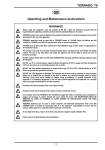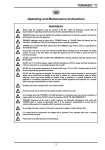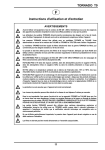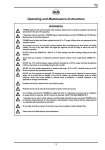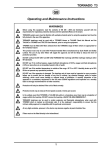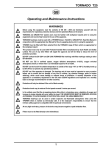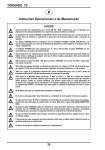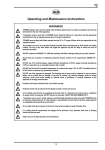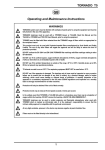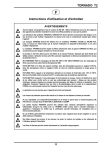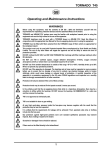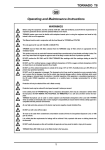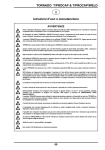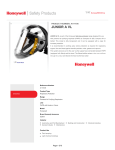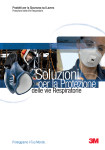Download T2 User Manual in English
Transcript
TORNADO T2 Operating and Maintenance Instructions WARNINGS Before using this equipment, read the contents of EN 529 : 2005 and familiarise yourself with the requirements for respiratory protective devices and their potential effects on the wearer. TORNADO and AIRLINE FCV system users must be familiar with workplace hazards prior to using the equipment and must be fully trained in the use of the apparatus. TORNADO head-tops must be used with a T/POWER blower, T/A/LINE or AIRLINE FCV. Read this Manual in conjunction with the appropriate User Manual for the air-supplying device prior to using the equipment. T/POWER must be fitted with filters selected from the TORNADO range of filters which are appropriate for the workplace hazard. This product must only be used with Protector-branded filters manufactured by Scott Health and Safety Limited. The use of any other filters will negate the approval and will be likely to reduce the level of protection provided. DO NOT confuse the EN 12941 and EN 12942 TORNADO filter markings with filter markings relating to other EN standards. DO NOT use T2 in confined spaces, oxygen deficient atmospheres (<19.5%), oxygen enriched atmospheres (>23%) or where there is an immediate hazard to life or health. DO NOT use the hood if the ambient temperature is outside of the range -10°C to +50°C. Humidity levels up to 95% RH do not present any operational problems. DO NOT use if the apparatus is damaged. The head-top and air hose must be inspected on every occasion before use to ensure that no damage of any kind is evident, (eg chemical damage, splits or broken stitching), which could cause leakage or reduced levels of protection. A monthly inspection of the apparatus is a mandatory requirement in the UK under COSHH regulations and inspection on a monthly basis is strongly recommended for all other countries. Protection will only be obtained if the unit is fitted correctly. Protection levels may be reduced if wind speed exceeds 2 metres per second. In the unlikely event that the air-supplying device fails while in a hazardous area, there may be a depletion of oxygen within the head-top. DO NOT remove the head-top, LEAVE THE AREA IMMEDIATELY. TORNADO head-tops can be used in certain explosive and flammable atmospheres when used with T/POWER which is marked as intrinsically safe. It is the employer’s responsibility to ensure that the intrinsic safety approval is compatible with the particular environment. At very high work-rates, pressure in the device may become negative at peak inhalation flow. It is unlikely that the requirements for leakage will be achieved if hair, spectacle side arms or clothing intrude into the face-seal. Filters must not be fitted directly to the helmet/hood. 1 TORNADO T2 SPECIFICATION Description: Full Hood and Cape Classification when used with: T/POWER T/A/LINE AIRLINE FCV EN 12941 TH3 EN 1835 LDH3 EN 14594 4B Minimum Design Flow Rate when used with: T/POWER T/A/LINE AIRLINE FCV 140 L/min 140 L/min 175 L/min Assigned* (Nominal) Protection Factor when used with: T/POWER T/A/LINE AIRLINE FCV 40 (500) 40 (200) 40 (2000) Operating Temperature Limits: Hood Air-supplying device -10°C to +50°C Refer to User Manual for air-supplying device being used. Material: Hood Polyurethane-coated nylon or polyurethane encased between two layers of textured nonwoven polypropylene. Acetate Visor Weight: 290 Grams * According to EN 529 : 2005 SELECTION OF AIR-SUPPLYING DEVICE The following table identifies which air-supplying device(s) is/are approved for use with each type of T2 head-top: Type of Head-top Part No. T2 Type of Air-supplying Device Description Full Hood and Cape - Standard + T2/AS Full Hood and Cape - Anti-static T2/SU Full Hood and Cape - Single-use + T/POWER T/A/LINE AIRLINE FCV ! ! ! ! ! " " ! " 12 Anti-static, surface resistivity of less than 1 x 10 Ohms. MARKINGS AND MEANINGS WEARING The T2 head-top markings are in conformance with EN 12941, as follows: Note: Remove the protective transit film from the outside and inside surfaces of the visor before donning. Marking SCOTT T2 T2/AS T2/SU CE 0086 EN12941 EN1835 EN14594 TH3 LDH3 4B Meaning Manufacturer - Scott Health & Safety Product name - T2 Standard Product name - T2 Anti-static Product name - T2 Single-use CE mark Certifying body Standard - powered respirator CAUTION: Whilst the materials which may come into contact with the wearer's skin are not known to be likely to cause skin irritation or other adverse effects to health, they may cause allergic reactions in particularly susceptible individuals. Standard - air supplied Class designation - EN 12941 Class designation - EN 1835 Class designation - EN 14594 1. Pull the face-piece over the head so that the visor is in front of the face. If necessary adjust the VelcroTM over-head strap for a comfortable fit. 2 TORNADO T2 • • MAINTENANCE T2 and T2/AS: adjust the drawstring for a comfortably tight fit around the neck. T2/SU: using the external tab on the hood, pull the seal over the chin until a comfortably tight fit around the neck is achieved. Carry out a thorough inspection of all component parts before and after each occasion of use, paying particular attention to the exhale valve flap. The valve flap must be replaced annually regardless of condition. Valve flaps in storage have a shelf-life of five years, after which time they should be discarded. 2. Ensure that hair and clothing are NOT trapped in the seal. 3. Arrange the breathing hose so that it trails freely down the back and is not kinked or looped. Exhalation valve flaps are marked with a code indicating the year of manufacture. The code ‘07' corresponds to 2007 and a dot is added each year thereafter, so ‘07.' would equate to 2008. 4. For further information, please refer to the User Manual for air-supplying device being used. RECORD INSPECTION AND MAINTENANCE DETAILS AFTER USE WARNING: DO NOT remove the face-piece until safely clear of the hazardous area. Record test and maintenance details on the Inspection and Maintenance Record Sheet provided at the back of this Manual. 1. Remove the hood, disconnect the hose and (if required) use a sponge moistened in warm water to clean and sanitise the face-piece and outer hose. Information recorded usually includes: • Name of employer responsible for the apparatus. • Make, model number or identification mark of the apparatus, together with a description of any distinguishing features, sufficient to enable clear identification. • Date of the inspection/ maintenance together with the name, signature or unique authentication mark of the examiner. • Condition of the apparatus, details of any defects found and any remedial action taken. CAUTION: • DO NOT use solvent or detergent cleaners as they may cause damage. • DO NOT allow water to enter the breathing hose. 2. Care should be taken not to scratch the visor. If the head cover or face-seal is damaged in any way, it should be replaced. STORAGE When not in use, the equipment should be stored in a clean, dry environment, away from direct heat sources between +10ºC and +30ºC, at a humidity of less than 65% RH. 3 TORNADO T2 SPARE PARTS Item No. 1 1 1 Description Hood - Standard Hood - Anti-static Hood - Single-use Part No. (Pack of 5) (Pack of 5) (Pack of 5) T2/HOOD T2/HOOD/AS T2/HOOD/SU 2 Exhale Valve Flap (Pack of 2) TOR/VALVE 3 Exhale Valve Cover (Pack of 5) 2017146 4 Support Washer (Pack of 5) 2016236 5 Breathing Hose (Pack of 3) T2/HOSE - Tear-off Visor Cover (Pack of 10) KIT96/VP 4 TORNADO T2 FITTING SPARES WARRANTY To Replace the Hose: The products manufactured at our factories in Skelmersdale and Vaasa carry a warranty of 12 months (unless stated otherwise) for parts, labour and return to site. The warranty period runs from the date of purchase by the end user. 1. Undo the nut on the rear inner hood, remove the support washer from the end of the hose and withdraw the hose. 2. Insert the new hose into the hood, fit the support washer over the end of the hose and secure with the nut. Ensure that both layers of hood fabric are trapped under the washer. These products are warranted to be free from defects in materials and workmanship at the time of delivery. SCOTT will be under no liability for any defect arising from wilful damage, negligence, abnormal working conditions, failure to follow the original manufacturer’s instructions, misuse or unauthorised alteration or repair. To Replace the Exhale Valve: 1. Pull the valve cover from the valve and pull the exhale valve flap from its housing. 2. Fit the replacement valve and check that the valve flap lies flat on the frame. Align the valve cover with the slots in the valve and snap it onto the valve. Evidence of purchase date will need to be provided for any claims arising during the warranty period. All warranty claims must be directed through SCOTT Customer Services and in accordance with our sales return procedure. NOTIFIED BODIES Inspec International Limited (0194) 56 Leslie Hough Way, Salford, Greater Manchester, M6 6AJ, England. BSI Product Services (0086) Kitemark House, Maylands Avenue, Hemel Hempstead, HP2 4SQ, England. 5






